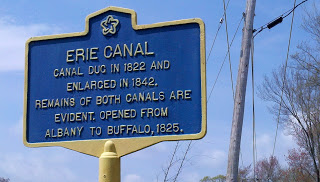It's a complex history that doesn't lend itself to easy slogans about government or the free market. Still, people try to employ it for their political ends. Here's a piece in the WSJ by Larry Schweikart and Burton Folsom on "Obama's False History of Public Investment." The piece has this subhead: "Entrepreneurs built our roads, rails and canals far better than government did." Then when you read the article, it contains a very brief overview of canal history:
America's 19th-century canal-building mania is now largely forgotten, but it is the granddaddy of misguided infrastructure-spending tales. Steamboats, first perfected by Robert Fulton in 1807, chugged along on all major rivers before states began using funds to build canals and harbors. Congress tried to get the federal government involved by passing a massive canal and road-building bill in 1817, but President James Madison vetoed it. New York responded by building the Erie Canal—a relatively rare success story. Most state-supported canals lost money, and Pennsylvania in 1857 and Ohio in 1861 finally sold their canal systems to private owners.
In Ohio, when the canals were privatized, one newspaper editor wrote: "Everyone who observes must have learned that private enterprise will execute a work with profit, when a government would sink dollars by the thousand."Me: The above is accurate as far as it goes, but it doesn't amount to "Entrepreneurs built our ... canals far better than government did." Canal building was mostly done by government, for better and worse. The financial troubles faced by many canals other than Erie, manifested in the Panic of 1837, spurred a turning away from government infrastructure for the rest of the 19th century, such that the railroads were built by the private sector (although government helped in various ways to make this happen). In the 20th century, the pendulum swung back toward government infrastructure projects, albeit with plenty of wobbling back and forth over the decades. It's also worth pointing out that what worked well in, say, 1825 may or may not be the best model for what should be done in 2013.
